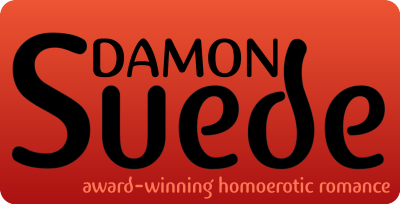Press Here
by Damon Suede
Marketing fiction can feel like hosting an all-you-can-eat barbecue where the guests never stop arriving, the kitchen never closes, and the chef is the cow. Moo!
Promoting your own work can devour hours. Publishers, bloggers, critics, readers, and retailers all need tidbits only you can supply and every minute you aren’t writing feels like a waste. Most writers cannot afford a publicist to handle the nitty-gritty of these chores, yet the idea of being their own publicist makes them queasy.
Still, an urgent demand for a squib, a photo, a logline can derail your entire day (and the day’s writing). Who hasn’t scrambled around looking for a bio at the right length or frantically reformatted a headshot for a conference which needed it yesterday?
Last minute is always too late.
The other side of the equation proves the point. Have you tried to link to an author’s site without being able to locate a banner and a site description? Or worse, ever needed info about a series and had to scrounge through reams of blog posts trying to find simple facts about chronology or awards? Forcing visitors to hunt for those basics discourages the promotional reciprocity that we need to cultivate. And that is bonkers!
Here’s the deal: Every working author needs their relevant details gathered in a single convenient location for easy access by fans, webmasters, reviewers, bloggers, and retailers. Online press kits (OPKs) have become standard operating procedure in most industries and following suit can only help the romance community.
Don’t make people work to get the word out.
The truth is, you already HAVE an OPK even if you don’t know it… The pieces may lie buried in folders and notes that aren’t immediately to hand, but every working writer keeps a stack of press clippings and advertising banners and headshots and possible blog topics. If you’re like me, this stuff clutters all your desktops, physical and digital.
My OPK saves my butt at least 4 times a week, sometimes twice that. As new material comes in I immediately slide it into the relevant place on the page, and when I get a request I shoot them the necessary materials AND a helpful link. Folks can just find the data on the page themselves, but I’d rather save them a step. By linking to my OPK in our correspondence I ensure they know where to look next time.
Help folks blow your horn.
Inevitably, the OPK serves as a resource for me AND the outside world saving time on both sides. Much of the content appears elsewhere on my website and social media pages, but gathering it in one easily-accessed place saves me a helluva lot of time when I’m on deadline and can’t remember where I put that 150x150 avatar a reviewer needs.
If you’re starting from scratch, just tackle it in baby steps. Begin with a few elements you have right in front of you, then supplement as time permits. Focus on the simple bits which often prove the most powerful and necessary: alternate lengths on blurbs & bios, links to your communities, cover art. Anything will be more helpful than nothing. My online press kit started small: a couple bios, social networking links, and a basic banner. The earliest iteration consisted mainly of stumps and spaces because my first novel hadn’t even released and I had no cover or reviews yet! Still, by laying the groundwork, I designated places for that content as it arrived and it did, faster and thicker than I could have imagined. The structure helped me sort through everything.
To create a powerful OPK, all you need to do is centralize, strategize, synergize. Your press kit will never be finished, but it needs to start now.
CENTRALIZE:
 This is the easiest step and will take
the least amount of time. Simply gather all of the marketing
components folks request regularly, include anything that you’ve had
to send to more than 3 entities that promote your work or love your
books. Again: the OPK exists to cut down on repetition and clutter,
so think it through…
This is the easiest step and will take
the least amount of time. Simply gather all of the marketing
components folks request regularly, include anything that you’ve had
to send to more than 3 entities that promote your work or love your
books. Again: the OPK exists to cut down on repetition and clutter,
so think it through…
What are the things you constantly distribute for publicity?: bios, banners, cover art, headshots, social media links, avatars, interview clips and links, videos, purchase & publisher links, event listings, maybe memberships and associations, possible blog topics and areas of expertise. In half an hour, you can assemble 90% of this stuff, because as a working writer, you already HAVE it somewhere.
Do the work for them.
OPTIONS: As you compile your material, provide versions that meet different needs. You cannot predict every eventuality, but I guarantee you can think of some regular (and irregular) requests that could be addressed before they come. So give your OPK browsers plenty of options and you’ll save yourself time down the road. Consider offering:
-
At least three lengths of bio: 50-75 words, 100-150 words, and 250-300 words seem a comfortable range.
-
3-5 sizes on each of your images (cover art, headshots, banners, avatars); a well-spaced range from 75pixels wide to 300 pixels wide will satisfy most folks. Don’t make them resize if they don’t have to.
-
Both hi-res and lo-res compression levels on A/V content (book videos/podcasts etc); Video & audio content are less common for niche publishing so if you have ‘em, flaunt ‘em (and host ‘em)!
Resolution: For images, video, and audio, graininess looks hideous and unprofessional. Format the eye candy at as high a resolution as possible without getting nutty. 300 dpi may be on the high-rez side, but will minimize pixelation and maximize utility for a range of uses. If you have any vector artwork (logos, fonting, etc), make sure to offer Adobe EPS or AI files. Additionally, for video & audio, several free players exist for hosting content to which another site can link easily. On that tip: host that content. Include easy-to-snag HTML tags for all the images/video/audio right there so folks can just link to your site.
PLACEHOLDERS: Missing stuff? “Nothing” is a perfect beginning! Make note of the absent elements and gaps that can be filled later. Consider material you might want to add as the need arises and your career develops. Possibilities include: sample interview questions, an event calendar, free fiction, relevant licensed artwork to accompany articles or blogs, character interviews etc. Use your imagination.
Keep loading the whole mess into a single, massive document until you think you’ve found everything. List the things you still need to create or acquire.
Once you have your pieces in a pile, it’s time to put the puzzle together.
STRATEGIZE:
Our goal in this phase is organizing for ease of access and brand coherence. First, arrange your press kit by demand, putting the most requested sections at the top. For some reason, I get a lot of e-mails asking for bios and links, whereas avatars and areas of expertise seem more of a specialty request from people with whom I already have a relationship. Here’s a possible structure:
-
Author Bios
-
Contact Links
-
Title list (including ISBN, length, publisher, release date, main character names)
-
Book Covers & Banners
-
Author Banners
-
Recognition: Quotes/Awards/Endorsements
-
A/V material
-
Avatars / Artwork
-
Headshots
-
Topics for Interviews & Articles
 Brand matters. Every author and every
book is different. Your OPK should be distinctive to your work and
your goals. If you’re making a big push for YouTube interviews, then
A/V might come earlier, if you want to promote a series of
educational articles, interview topics might lead the list. In
essence, your goal should be to frontload the popular info, yet
include things visitors might not even have thought to request.
Brand matters. Every author and every
book is different. Your OPK should be distinctive to your work and
your goals. If you’re making a big push for YouTube interviews, then
A/V might come earlier, if you want to promote a series of
educational articles, interview topics might lead the list. In
essence, your goal should be to frontload the popular info, yet
include things visitors might not even have thought to request.
Once you have a rough shape, think about how you can streamline it and solve problems in advance. Ultimately when anyone searches for your name on the web, your OPK should appear as close to the top of the list as possible and visitors should be able to locate what they need swiftly and intuitively. Folks only have to ask if you don’t make things easy to find.
Communicate clearly.
NAVIGATION: Divide the OPK into discrete, easy-to-navigate sections with LOTS of crosslinking so people don’t have to scroll all the hell over. Remember: this webpage should help folks who will be in a hurry to get what they need. Make sure to include many handy “Back to Top” links that will whisk them back to the Table of Contents.
ACCESS: Make the OPK easy to find or they won’t find it. Include a link to your online press kit on EVERY page of your website. Include a way to contact you if they need something you’ve forgotten, and then the moment you’ve rustled it up, add it to the press kit for the next visitor. Again: transparency is the goal.
Professionalism counts and marketing matters. Every millimeter of the OPK should sell you and your books in a logical structure. People want to help you. Ensure that their attention accomplishes what you want.
SYNERGIZE:
So now that you assembled all your pieces in a useful shape, you need to polish that page like there’s no mañana! In essence, this final phase never ends, evolving throughout your career so your OPK continues to keep your “brand” in the fire, so to speak.
Help your components produce an effect greater than the sum of their parts. Fill the gaps as you can and constantly improve on what’s already in place. This press kit needs to pitch you and your writing to the entire Web as firmly and positively as possible. Brand yourself, and then help that brand evolve over time so you can stand out in a crowded field. Keep your content fresh and current. The more you give visitors what they need, in a way that supports your own marketing message, the more their coverage will resonate with your branding.
Build a better publicist.
Who couldn’t use a clever, devoted press secretary who works 24/7 for no pay? Like a devoted employee, your OPK becomes your first line of defense against distractions and simply answered requests. You’ll waste less time on those essential, redundant PR chores. Remember: by doing light steady maintenance, it will stay strong and topical. Investing a half hour a week in OPK grooming will save days of wasted time when you should be writing something new.
I tend to think of my online press kit
(and by extension my entire website) as a fussy Persian cat that
needs grooming and pampering to keep purring. Run a brush over the
tangles a couple times a week. Feed it treats and fresh tidbits.
Don’t abandon it for long stretches. Every time a new review comes
in, pull the hot phrases and add it to the mix. Every time you get
new cover art, render it in several resolutions/dimensions. Revisit
and revamp regularly as you find better verbiage, sexier quotes, or
cooler images to keep it current and to inspire promotional
opportunities.
Accentuate the positive and keep all your materials consonant with your brand.
Clarify the kinds of books you write: If you write in a specific subgenre, weave its timbre through all of your materials. If your stories are funny then make sure your OPK and all the materials included anchor the sense of humor in your brand from font choices to layout. If you specialize in provocative erotica, make sure your bio anecdotes, your banner artwork, and even the logline language all strike the appropriate tone. Consider colors, shapes, word choices with the ruthless precision of an ad exec angling for a promotion. Your work deserves that kind of passion and mindfulness.
Clarify who you are: Your bio must support your brand as an author. If your books are funny, be funny, if they’re gritty, stay gritty. Emphasize any element of your skillset or personality that tends to attract readers. If you are particularly good on camera or audio, include clips of yourself to draw people in. If your expertise, your fetishes, or even your dimples will interest your readers, make sure they get play in the OPK. Help people tell the world about you.
The Handy dandy Swiss-Army PRESS KIT:
Only YOU can make your press kit all it can be. No one knows your work better than you, so no one can or will sell it with your care and enthusiasm. What about you and your work will get the right kind of attention? What are the elements which provide the simplest, strongest entry point for someone unfamiliar with your backlist? Make your content singular and memorable. Building a robust OPK will help you identify your brand, refine it, and push it further.
Stay vigilant about finding new hooks, angles, and “sizzle” for lack of a better word. What will they want to know? Where have you been and where are you headed? What should fans anticipate from you? Why do new readers need to take a closer look? How will your brand and your books evolve and how can your online content reflect and support that future?
Spin is critical and sizzle sells… especially as niche markets push the boundaries of mainstream appetites. The publishing landscape changes daily, and LGBT fiction along with it. For M/M romance in particular, what started as an outgrowth of fan fiction has evolved into a lucrative global industry that gains traction by staying competitive.
A centralized, strategized, synergized online press kit works for you, feeding the marketing mob so you can spend your time writing the next book as you ought. Remember: the next book does more to sell your work and build your brand than anything else.
At the end of the day, the sizzle only matters if there’s steak on the plate.

Originally published in the Pot of Gold (#10, Q4,
2011), the
newsletter of the
Rainbow Romance Writers chapter of the Romance Writers of America
If you wish to republish this article, just drop me a line.

